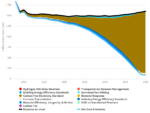Presidential candidates, state governments, and utilities are promoting “net zero” emissions targets to preserve a safe climate future by helping to limit global warming to well below 2°C – but few of them have defined exactly how the United States could remake its energy economy.
The Paris Agreement targets net zero emissions by 2050. More than 60 countries, including Germany and the United Kingdom, have set net zero, showing how political momentum can spur climate action – if the policy path forward is clear.
Energy Innovation previously modeled a scenario to achieve the U.S. Paris Agreement pledge using the peer-reviewed and open-source Energy Policy Simulator (EPS), it now uses the EPS to explore an illustrative policy pathway to achieve net zero U.S. emissions by 2050.
By 2050, EI’s net zero pathway abates more than 6 Gt of emissions a year and saves more than 120,000 American lives per year due to reduced particulate pollution. This series of four articles identifies the policy combinations that can decarbonize America’s industrial, transportation, electricity, and buildings sectors.
While emissions reductions from land use and agriculture represent roughly a tenth of those needed to reach net zero emissions, this series does not focus on that sector.
How To Reach U.S. Net Zero Emissions By 2050: Decarbonizing Industry
Industrial emissions are 35 percent of U.S. emissions, or 29 percent if emissions from generating electricity are grouped into a separate sector. Under business-as-usual, industrial emissions are projected to rise more than 35 percent by 2050.
Increasing electrification and hydrogen in industrial energy use provides 38 percent of emissions abatement in a net zero scenario; material efficiency, longevity, and re-use 21 percent; replacing fluorinated gases 14 percent; and other policies contribute the remainder of required abatement.
How To Reach U.S. Net Zero Emissions By 2050: Decarbonizing Transportation
Transportation emissions are 27 percent of U.S. emissions, and while light-duty emissions are projected to steadily decline due to vehicle electrification, emissions from other vehicles are expected to increase through 2050.
A 100 percent by 2030 all-electric sales mandate for most vehicles, and 50 percent by 2030 for medium- and heavy-duty trucks contribute 73 percent of emissions abatement in a net zero scenario; transportation demand management 13 percent; a 50 percent by 2040 hydrogen sales mandate for medium- and heavy-duty trucks 12 percent; and other policies contribute the remainder of required abatement.
How To Reach U.S. Net Zero Emissions By 2050: Decarbonizing Electricity
Electricity generation is responsible for 26 percent of U.S. emissions, and because it is the backbone of the American energy system, decarbonization in this sector can reduce emissions in the other three sectors through rapid electrification.
A 100 percent by 2050 carbon-free electricity standard which includes wind and solar as well as resources like hydropower and nuclear power, can fully decarbonize U.S. electricity generation. Complementary power sector policies like increasing transmission infrastructure, grid flexibility, and energy efficiency make reaching 100 percent clean electricity much easier. Other policies in industry, buildings, and transportation contribute the remainder of required abatement.
How To Reach U.S. Net Zero Emissions By 2050: Decarbonizing Buildings
Buildings are responsible for 27 percent of U.S. emissions, or 8 percent if emissions from generating power are grouped into a separate sector. Under business-as-usual, emissions from buildings are expected to remain constant through 2050.
An all-electric by 2035 sales mandate drives 87 percent of emissions reductions from U.S. buildings, with financial incentives for retrofits and building and equipment efficiency contributing the remainder of required abatement. Other policies to support building electrification like financial incentives for retrofits, building and equipment efficiency standards, and green building codes also contribute emissions reductions.




